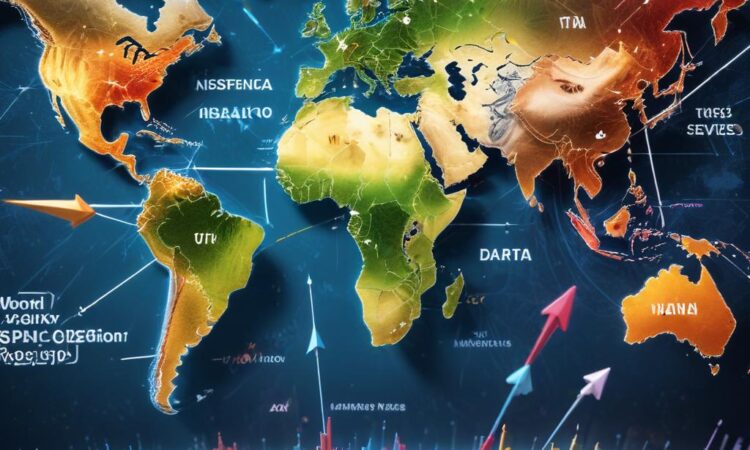Global Inflation and Interest Rates: A Complex Landscape
Central banks around the world continue to grapple with high inflation, leading to adjustments in interest rates. Recent data releases and statements from policymakers are closely watched for clues on the future trajectory of monetary policy.
The Global Inflationary Pressure
Inflation has surged globally, driven by a confluence of factors, including supply chain disruptions stemming from the COVID-19 pandemic, the war in Ukraine, and robust consumer demand. Many countries are experiencing inflation rates not seen in decades, putting significant strain on household budgets and eroding purchasing power.
The following are some of the key factors contributing to the current inflationary environment:
- Supply Chain Bottlenecks: The pandemic disrupted global supply chains, leading to shortages of essential goods and materials. This has pushed up prices across a range of sectors.
- Energy Price Volatility: The war in Ukraine has exacerbated energy price volatility, particularly for oil and natural gas. This has a significant impact on transportation costs and the price of many goods and services.
- Strong Consumer Demand: Governments implemented fiscal stimulus measures during the pandemic, which, combined with pent-up demand, has led to robust consumer spending. This has fueled demand-pull inflation.
- Labor Market Tightness: Many countries are experiencing labor shortages, which has driven up wages and increased costs for businesses.
- Geopolitical Tensions: Geopolitical tensions and sanctions have disrupted trade flows and added to supply chain uncertainties, further contributing to inflationary pressures.
Central Bank Responses: Raising Interest Rates
In response to high inflation, central banks around the world are implementing monetary tightening policies, primarily through interest rate hikes. The goal is to curb demand and slow economic growth, thereby reducing inflationary pressures.
The Federal Reserve in the United States, the European Central Bank (ECB), and the Bank of England are among the major central banks that have embarked on aggressive interest rate hikes. These rate increases have a direct impact on borrowing costs for businesses and consumers, potentially slowing down economic activity.
The Impact on Global Economies
The interplay between inflation and interest rates has significant implications for global economies. Raising interest rates can help tame inflation, but it also carries the risk of slowing economic growth too abruptly. This can lead to a recession if not managed carefully.
There are several potential consequences of aggressive interest rate hikes:
- Slower Economic Growth: Higher interest rates increase the cost of borrowing for businesses and consumers, potentially leading to reduced investment and spending, and ultimately, slower economic growth.
- Job Losses: As businesses face higher borrowing costs and weaker demand, they may be forced to cut jobs, leading to unemployment.
- Financial Market Volatility: Rising interest rates can lead to increased volatility in financial markets, as investors adjust their portfolios in response to changing economic conditions.
- Debt Burden: Higher interest rates increase the cost of servicing existing debt, potentially putting strain on businesses and households with high debt levels.
Challenges Facing Central Banks
Central banks face a delicate balancing act in navigating the current economic environment. They must raise interest rates enough to bring inflation under control while avoiding excessive tightening that could trigger a recession.
Some of the challenges facing central banks include:
- Lagged Effects: Monetary policy actions often have a lagged effect on the economy. It can take months for interest rate hikes to fully impact inflation and economic activity.
- Uncertainty about the Future: The global economic outlook is uncertain, with risks stemming from geopolitical tensions, supply chain disruptions, and potential global recessions. This makes it difficult for central banks to assess the appropriate level of interest rate increases.
- Inflationary Expectations: Central banks need to manage inflationary expectations. If people expect inflation to remain high, they may demand higher wages and prices, perpetuating the cycle of rising prices.
The Path Forward: Navigating the Complexities
The outlook for inflation and interest rates remains uncertain. Central banks will need to carefully monitor economic data and adjust monetary policy accordingly. The path forward will require a delicate balance of managing inflation and supporting economic growth.
There are several key factors that will influence the future trajectory of inflation and interest rates:
- The Pace of Economic Growth: The rate of economic growth will play a significant role in determining inflation pressures. If economic growth slows down, inflation is likely to moderate.
- Supply Chain Dynamics: The resolution of supply chain bottlenecks will have a major impact on inflation. As supply chains become more efficient, prices are expected to stabilize.
- Geopolitical Developments: The outcome of the war in Ukraine and other geopolitical events will have a significant impact on energy prices, trade flows, and global economic stability.
- Government Policy: Fiscal policy decisions by governments will also influence inflation and interest rates. For example, government spending can stimulate demand and contribute to inflation.
The current global inflationary environment is complex and presents significant challenges for policymakers. As central banks navigate these challenges, it is essential to maintain transparency and clear communication with the public. The path forward will require a collaborative effort from governments, central banks, and businesses to restore price stability and foster sustainable economic growth.

